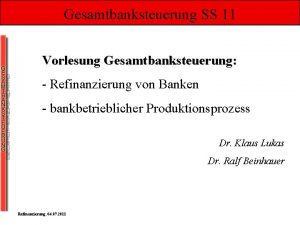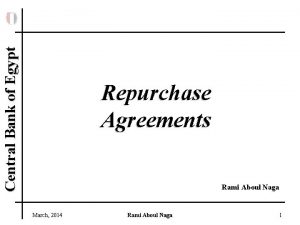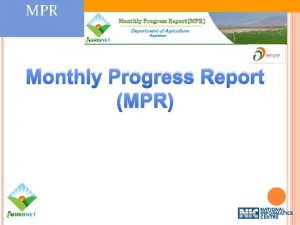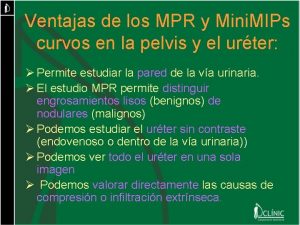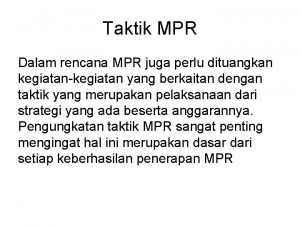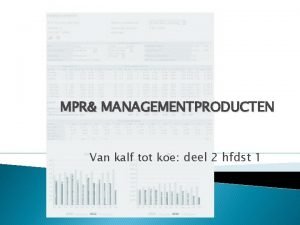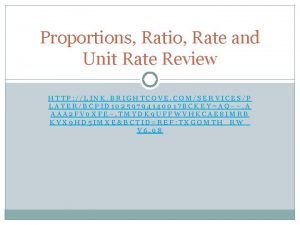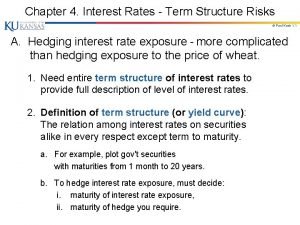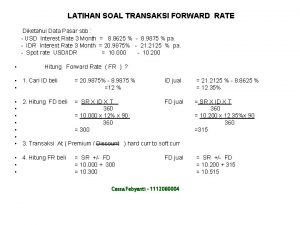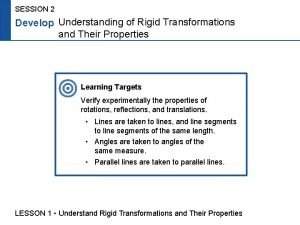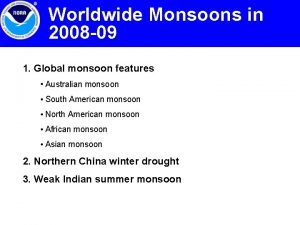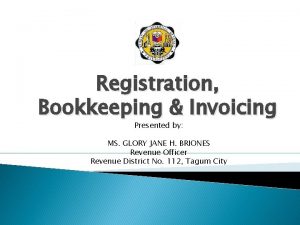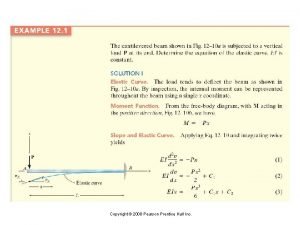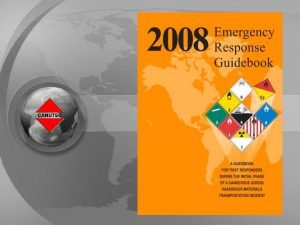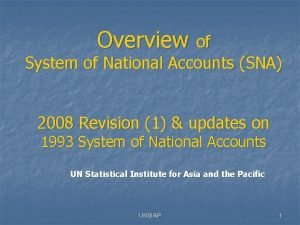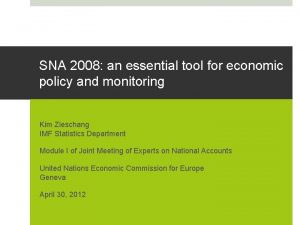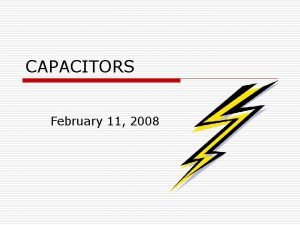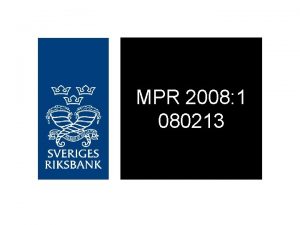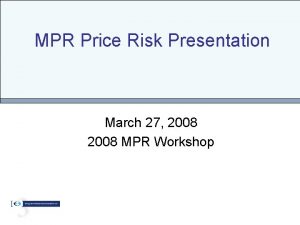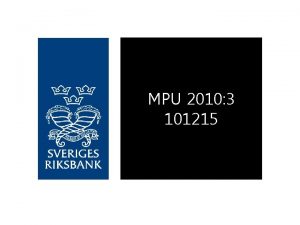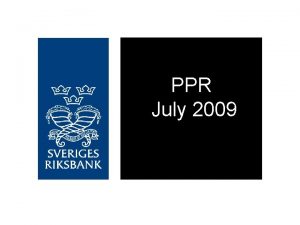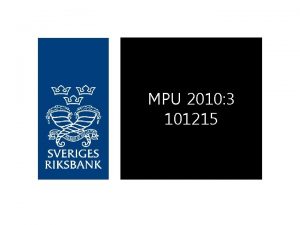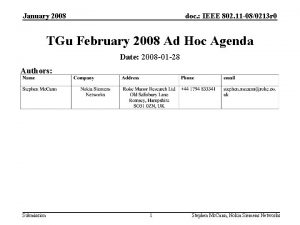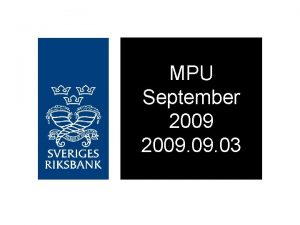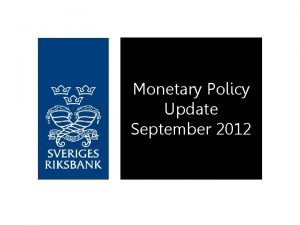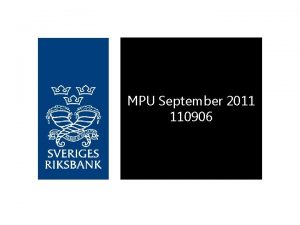MPR 2008 1 080213 Figure 1 Repo rate










































































































- Slides: 106

MPR 2008: 1 080213

Figure 1. Repo rate with uncertainty bands Per cent, quarterly averages Source: The Riksbank

Figure 2. GDP with uncertainty bands Annual percentage change, seasonally adjusted data Sources: Statistics Sweden and the Riksbank

Figure 3. CPI with uncertainty bands Annual percentage change Sources: Statistics Sweden and the Riksbank

Figure 4. CPIX with uncertainty bands Annual percentage change Sources: Statistics Sweden and the Riksbank

Figure 5. Fluctuations in government bond rates Per cent Note: Calculated as 30 -day rolling standard deviation for 2 -year rates. Source: Reuters Eco. Win

Figure 6. GDP in the USA and the Euro area Quarterly change in per cent, in annualised terms, seasonally adjusted data Sources: Bureau of Economic Analysis, Eurostat and the Riksbank

Figure 7. Consensus and the Riksbank’s forecasts for GDP growth in the United States in 2008 at different points in time Annual percentage change 2007 2008 Sources: Consensus Economics Inc. and The Riksbank

Figure 8. GDP in Sweden and the world Annual percentage change Sources: IMF, Statistics Sweden and the Riksbank

Figure 9. Total Swedish exports and export market index for goods Annual percentage change Sources: Statistics Sweden and the Riksbank

Figure 10. Real exchange rate and current account TCW index, 18 November 1992 = 100 and percentage of GDP Note. Broken lines represent the Riksbank’s forecast. Sources: Statistics Sweden and the Riksbank

Figure 11. TCW exchange rate Index, 18 November 1992 = 100 Note. Broken lines represent the Riksbank’s forecast. Source: The Riksbank

Figure 12. GDP Quarterly change in per cent, in annualised terms, seasonally adjusted data Note. Broken lines represent the Riksbank’s forecast. Sources: Statistics Sweden and the Riksbank

Figure 13. Households’ disposable incomes, consumption and saving ratio Annual percentage change, fixed prices and percentage of disposable income Sources: Statistics Sweden and the Riksbank

Figure 14. Labour force and number employed Thousands, seasonally adjusted data Note. Broken lines represent the Riksbank’s forecast. Sources: Statistics Sweden and the Riksbank

Figure 15. Percentage of open unemployed 16 -64 years-old and percentage of unemployed 15 -74 years according to the new EU ordinance Percentage of the labour force, seasonally adjusted data Note. Broken lines represent the Riksbank’s forecast. Sources: Statistics Sweden and the Riksbank

Figure 16. Actual an trend labour productivity for the economy as a whole Annual percentage change, seasonally adjusted data Sources: Statistics Sweden and the Riksbank

Figure 17. Unit labour costs for the economy as a whole Annual percentage change, seasonally adjusted data Sources: Statistics Sweden and the Riksbank

Figure 18. CPI and CPIX Annual percentage change Note. Broken lines represent the Riksbank’s forecast. Sources: Statistics Sweden and the Riksbank

Figure 19. Oil price, Brent crude USD per barrel Sources: Intercontinental Exchange and the Riksbank

Figure 20. CPIX excluding energy Annual percentage change Note. Broken lines represent the Riksbank’s forecast. Sources: Statistics Sweden and the Riksbank

Figure 21. Repo rate forecasts on different occasions Per cent, quarterly averages Note. Broken lines represent the Riksbank’s forecast. Source: The Riksbank

Figure 22. CPIX forecasts on different occasions Annual percentage change Note. Broken lines represent the Riksbank’s forecast. Sources: Statistics Sweden and the Riksbank

Figure 23. Employment forecasts on different occasions Thousands, seasonally adjusted data Note. Broken lines represent the Riksbank’s forecast. Sources: Statistics Sweden and the Riksbank

Table 1. Inflation, annual average Annual percentage change Note. The assessment in the Monetary Policy Update In December 2007 is stated in parentheses. Sources: Statistics Sweden and the Riksbank

Table 2. Inflation, 12 -month rate Annual percentage change Note. The assessment in the Monetary Policy Update In December 2007 is stated in parentheses. Sources: Statistics Sweden and the Riksbank

Table 3. Key figures Annual percentage change, unless otherwise stated *New weights from the World bank have been used for the aggregate world growth for the previous forecast, too. These values thus do not correspond to those published in the Monetary Policy Update in December 2007. Note. The assessment in the Monetary Policy Update In December 2007 is stated in parentheses. Sources: Statistics Sweden and the Riksbank

Table 4. Repo rate forecast Per cent, quarterly average Note. The assessment in the Monetary Policy Update In December 2007 is stated in parentheses. Source: The Riksbank

Figure 24. Repo rate assumptions Per cent, quarterly averages Note. Broken lines represent the Riksbank’s forecast. Source: The Riksbank

Figure 25. CPIX Annual percentage change Note. Broken lines represent the Riksbank’s forecast. Sources: Statistics Sweden and the Riksbank

Figure 26. GDP Annual percentage change, seasonally adjusted data Note. Broken lines represent the Riksbank’s forecast. Sources: Statistics Sweden and the Riksbank

Figure 27. Output gaps (GDP) Percentage deviation from the HP trend Note. Broken lines represent the Riksbank’s forecast. Sources: Statistics Sweden and the Riksbank

Figure 28. Labour market gaps Percentage deviation from the HP trend Note. Broken lines represent the Riksbank’s forecast. Sources: Statistics Sweden and the Riksbank

Figure 29. Number of hours worked Annual percentage change, seasonally adjusted data Note. Broken lines represent the Riksbank’s forecast. Sources: Statistics Sweden and the Riksbank

Figure 30. Employment rate Per cent, seasonally adjusted data Note. Broken lines represent the Riksbank’s forecast. Sources: Statistics Sweden and the Riksbank

Figure 31. Open unemployment according to the ILO definition Percentage of the labour force, seasonally adjusted data Note. Broken lines represent the Riksbank’s forecast. Sources: Statistics Sweden and the Riksbank

Figure 32. GDP, scenario wiith greater financial turmoil Annual percentage change, seasonally adjusted data Note. Broken lines represent the Riksbank’s forecast. Sources: Statistics Sweden and the Riksbank

Figure 33. CPIX, scenario with greater financial turmoil Annual percentage change, seasonally adjusted data Note. Broken lines represent the Riksbank’s forecast. Sources: Statistics Sweden and the Riksbank

Figure 34. Repo rate, scenario with greater financial turmoil Per cent, quarterly averages Note. Broken lines represent the Riksbank’s forecast. Source: The Riksbank

Figure 35. GDP, scenario with higher international inflation Annual percentage change, seasonally adjusted data Note. Broken lines represent the Riksbank’s forecast. Sources: Statistics Sweden and the Riksbank

Figure 36. CPIX, scenario with higher international inflation Per cent, quarterly averages Note. Broken lines represent the Riksbank’s forecast. Sources: Statistics Sweden and the Riksbank

Figure 37. Repo rate, scenario with higher international inflation Per cent, quarterly averages Note. Broken lines represent the Riksbank’s forecast. Sources: Statistics Sweden and the Riksbank

Figure 38. Oil price, scenario with higher oil price USD/barrel Note. Broken lines represent the Riksbank’s forecast. Sources: Statistics Sweden and the Riksbank

Figure 39. The difference between interbank rates and government bond rates Basis points Source: The Riksbank

Figure 40. Interbank rates in Sweden Per cent Note. STIBOR T/N refers to overnight right from tomorrow until the day after. Source: The Riksbank

Figure 41. Spread between interbank rates and expected monetary policy Basis points Source: The Riksbank

Figure 42. Interest rates in Sweden Per cent Source: SBAB and the Riksbank

Figure 43. GDP Annual percentage change Sources: Eurostat, OECD and the US Department of Commerce

Figure 44. Employment and private consumption in the United States Annual percentage change Sources: Bureau of Labor Statistics and Department of Commerce

Figure 45. Confidence indicators in the euro area. Balance, deviations from averages 1995 -2007 Source: European Commission

Figure 46. Confidence indicators for households and for manufacturing companies in the United Kingdom Balance, deviations from averages 1990 -2007 Note. Broken lines are averages of the respective curves from 1990. Source: European Commission

Figure 47. HICP in the euro area Annual percentage change Source: Eurostat

Figure 48. Monetary policy expectations in the Euro area and the United States Per cent Source: The Riksbank

Diagram 49 Monetary policy expectations in Sweden Per cent Sources: Prospera Research AB and the Riksbank

Figure 50. Long-term interest rates Per cent Note. Government bonds with approximately 10 years left to maturity. Source: Reuters Eco. Win

Figure 51. Exchange rate movements SEK/EUR and SEK/USD Source: The Riksbank

Figure 52. TCW exchange rate Index, 18 November 1992 = 100 Source: The Riksbank

Figure 53. Stock market movements Index, 1 January 1999 = 100 Source: Reuters Ecowin

Figure 54. The money supply Annual percentage change Sources: Statistics Sweden and the Riksbank

Figure 55. House prices and total lending to Swedish households Annual percentage change Sources: Statistics Sweden and the Riksbank

Figure 56. GDP Quarterly change in per cent, in annualised terms, seasonally adjusted data Sources: Statistics Sweden and the Riksbank

Figure 57. Confidence indicators for major industries Seasonally adjusted balance Source: National Institute of Economic Research

Figure 58. Gross fixed capital formation Annual percentage change Source: Statistics Sweden and The Riksbank

Figure 59. Foreign trade with goods at fixed prices Annual percentage change, seasonally adjusted data Note. Three month moving average Source: Statistics Sweden and The Riksbank

Figure 60. Retail sales and household consumption Annual percentage change Sources: The National Institute of Economic Research and Statistics Sweden

Figure 61. Household expectations of the future Balance Sources: Statistics Sweden and the Riksbank

Figure 62. New and unfilled vacant jobs and redundancy notices. Thousands, seasonally adjusted data Note. Three month moving average. Source: Swedish Public Employment Service

Figure 63. Vacancies and redundancy notices Thousands, seasonally adjusted data Source: Statistics Sweden

Figure 64. Hiring plans and number of employed in the business sector Balance and annual percentage change Sources: National Institute of Economic Research and Statistics Sweden

Figure 65. Labour productivity for the economy as a whole Annual percentage change, seasonally adjusted data Sources: Statistics Sweden and the Riksbank

Figure 66. Estimated HP gaps Percentage deviation from HP trend Sources: Statistics Sweden and the Riksbank

Figure 67. Capacity utilisation in industry Per cent, seasonally adjusted data Sources: The National Institute of Economic Research and Statistics Sweden

Figure 68. Proportion of firms reporting a shortage of labour Per cent, seasonally adjusted data Source: National Institute of Economic Research

Figure 69. Employment rate Proportion of the population aged 16 -64 in the labour force Note. Pre-1993 data has been spliced by the Riksbank. Sources: Statistics Sweden and the Riksbank

Figure 70. Wages in the construction, service and manufacturing sectors Annual percentage change Note. Three month moving average. Sources: National Mediation Office

Figure 71. Unit labour costs for the economy as a whole Annual percentage change, seasonally adjusted data Sources: Statistics Sweden and the Riksbank

Figure 72. Wage share Labour costs' share of the added value Note. Four-quarter moving average. Sources: Statistics Sweden and the Riksbank

Figure 73. Actual inflation (CPI) and households’ and companies’ expectations of inflation one year ahead Annual percentage change Sources: National Institute of Economic Research and Statistics Sweden

Figure 74. Different agents’ expectations of inflation two years ahead Annual percentage change Source: Prospera Research AB

Figure 75. The difference between nominal and inflation-linked five-year rates (break-even inflation) Percentage points Source: The Riksbank

Figure 76. CPI, CPIX and CPIX excluding energy Annual percentage change Sources: Statistics Sweden and the Riksbank

Figure 77. CPIX excluding energy, broken down into goods, services and food Annual percentage change Sources: Statistics Sweden and the Riksbank

Figure 78. Producer prices Annual percentage change Source: Statistics Sweden

Figure 79. Commodity prices UDS, annual percentage change Source: The Economist

Figure 80. Different measures of underlying inflation Annual percentage change Sources: Statistics Sweden The Riksbank

Table 5. Indicators for GDP in the short term Sources: National Institute of Economic Research, Statistics Sweden and the

Figure B 1. Energy prices in the CPI adjusted for the effects of changes in indirect taxes Annual percentage change Sources: Statistics Sweden and the Riksbank

Figure B 2. CPIX inflation and direct and indirect effects of changes in energy prices during the period 2002 -2007 Annual percentage change and percentage points Sources: Statistics Sweden and the Riksbank

Figure B 3. The Economists commodity price index for food USD, annual percentage change Source: The Economist

Figure B 4. Consumer and producer food prices Annual percentage change Sources: Statistics Sweden and the Riksbank

Figure B 5. Food price in the CPI in some countries Annual percentage change Sources: The respective countries’ statistical agencies

Table A 1. Inflation, 12 -month rate Annual percentage change Sources: Statistics Sweden and the Riksbank

Table A 2. Change in CPI compared to change in CPIX Annual percentage change and percentage points * Contribution to CPI-inflation, per cent Sources: Statistics Sweden and the Riksbank

Table A 3. Interest rates, exchange rates and public finances Per cent, annual average Sources: Statistics Sweden and the Riksbank

Table A 4. International conditions Annual percentage change *New weights from the World bank have been used for the aggregate world growth for the previous forecast, too. These values thus do not correspond to those published in the Monetary Policy Update in December 2007. Sources: IMF, Intercontinental Exchange, OECD, Statistics Sweden and the Riksbank

Table A 5. GDP and GDP by expenditure Annual percentage change * Contribution to GDP growth, percentage points Sources: Statistics Sweden and the Riksbank

Table A 6. Output, employment and unemployment Annual percentage change, unless otherwise else indicated * Percentage of the labour force Sources: National Labour market Board, Statistics Sweden and the Riksbank

Table A 7. Wages, productivity and labour costs for the economy as a whole Annual percentage change, calendar-adjusted data Sources: National Mediation Office, Statistics Sweden and the Riksbank

Table A 8. Repo rate Per cent, annual average Source: The Riksbank

Table A 9. CPIX Annual percentage change Sources: Statistics Sweden and the Riksbank

Table A 10. GDP Annual percentage change, calendar-adjusted data Source: The Riksbank

Table A 11. Hours worked Annual percentage change, calendar-adjusted data Sources: Statistics Sweden and the Riksbank

Table A 12. Percentage of unemployed 16 -64 yearolds, according to ILO definition Per cent of labour force, calendar-adjusted data Sources: Statistics Sweden and the Riksbank

Table A 13. Scenario with greater financial turmoil Annual percentage change unless otherwise specified * Per cent, annual average Note. Main scenario forecast in brackets. Sources: Statistics Sweden and the Riksbank

Table A 14. Scenario with higher international inflation Annual percentage change unless otherwise specified * Per cent, annual average Note. Main scenario forecast in brackets. Sources: Statistics Sweden and the Riksbank

Table A 15. Scenario with higher oil price Annual percentage change unless otherwise specified * Per cent, annual average Note. Main scenario forecast in brackets. Sources: Intercontinental Exchange, Statistics Sweden and the Riksbank
 Repo rate definition
Repo rate definition Repo rate formula
Repo rate formula Repurchase agreement (repo) und wertpapierleihe
Repurchase agreement (repo) und wertpapierleihe 50 repo
50 repo Types of naga
Types of naga Repo
Repo Suse open source
Suse open source Callie wall
Callie wall Reverse repo definitie
Reverse repo definitie 2008 2008
2008 2008 Marketing sektor publik
Marketing sektor publik Thomas l harris marketing public relations
Thomas l harris marketing public relations Monthly mpr
Monthly mpr Marketing public relations (mpr)
Marketing public relations (mpr) Mpr it
Mpr it Mip mpr
Mip mpr Ricostruzioni multiplanari
Ricostruzioni multiplanari Mpr uitslag
Mpr uitslag Mpr project management
Mpr project management Taktik mpr
Taktik mpr Voxel isotropico e anisotropico
Voxel isotropico e anisotropico Reactive mpr
Reactive mpr Marketing public relations (mpr)
Marketing public relations (mpr) Mpr jaaroverzicht
Mpr jaaroverzicht Insemineren
Insemineren Mpr marketing
Mpr marketing Mpr
Mpr Perbedaan cpr dan mpr
Perbedaan cpr dan mpr Visi misi mpr
Visi misi mpr Erp in operations management
Erp in operations management Unit rate proportions
Unit rate proportions Cap rate interest rate relationship
Cap rate interest rate relationship Real exchange rate formula
Real exchange rate formula Nominal v. real interest rates
Nominal v. real interest rates Oas spread
Oas spread What is growth analysis
What is growth analysis Spot rate and forward rate
Spot rate and forward rate Contoh transaksi forward
Contoh transaksi forward Pentagon plane figure or solid figure
Pentagon plane figure or solid figure A transformation is an operation that
A transformation is an operation that 6 figure map
6 figure map Rigid transformation review
Rigid transformation review T. trimpe 2008 http://sciencespot.net/
T. trimpe 2008 http://sciencespot.net/ 2008 generation called
2008 generation called Lingkungan msdm (mondy 2008)
Lingkungan msdm (mondy 2008) 22 mei 2008
22 mei 2008 C-2008
C-2008 Double mona lisa peanut butter and jelly
Double mona lisa peanut butter and jelly Medina 2008
Medina 2008 Ohsas 18001:2008
Ohsas 18001:2008 Padrão ieee 754
Padrão ieee 754 2008 fashion middle school
2008 fashion middle school 2008 pearson education inc
2008 pearson education inc 2008
2008 Sirim product testing
Sirim product testing Hendl 2008
Hendl 2008 Eureka puc pr
Eureka puc pr Iso 9004:2008
Iso 9004:2008 Melanie nind 2008
Melanie nind 2008 Copyright 2003 pearson education inc
Copyright 2003 pearson education inc Mansoon desk 2008
Mansoon desk 2008 Www middleschoolscience com 2008
Www middleschoolscience com 2008 Subdomínios
Subdomínios Erg white pages
Erg white pages Sql server management studio express 2005
Sql server management studio express 2005 Lingkungan msdm (mondy 2008)
Lingkungan msdm (mondy 2008) 나모 웹에디터
나모 웹에디터 Lingkungan msdm (mondy 2008)
Lingkungan msdm (mondy 2008) Jollibee kids meal 2008
Jollibee kids meal 2008 20 desember 2008
20 desember 2008 Rmc 82-2008
Rmc 82-2008 En el 2008
En el 2008 Rys 9 1998
Rys 9 1998 12th may 2008
12th may 2008 Pearson education limited 2008
Pearson education limited 2008 Autodesk inventor 2008
Autodesk inventor 2008 Copyright 2008
Copyright 2008 Pearson education limited 2008
Pearson education limited 2008 2008
2008 6/3/2008
6/3/2008 2008 pearson prentice hall inc
2008 pearson prentice hall inc Pearson education 2008
Pearson education 2008 29 maret 2008
29 maret 2008 Die welle 2008
Die welle 2008 Stm gsm
Stm gsm Orange section of emergency response guidebook
Orange section of emergency response guidebook 2008-1969
2008-1969 Sni 3932:2008
Sni 3932:2008 T trimpe
T trimpe Molecular biology of the cell
Molecular biology of the cell Primavera 2008
Primavera 2008 Sna 2008
Sna 2008 Xcelsius 2008
Xcelsius 2008 Pp nomor 74 tahun 2008
Pp nomor 74 tahun 2008 Liberia census 2008 results
Liberia census 2008 results Mansoon desk 2008
Mansoon desk 2008 Menurut scarborough dan zimmerer
Menurut scarborough dan zimmerer Bagaimana asas penilaian buku
Bagaimana asas penilaian buku Anes 2008
Anes 2008 12.02.2008 nasa
12.02.2008 nasa Sna 2008
Sna 2008 Cve-2008-4250
Cve-2008-4250 World energy outlook 2008
World energy outlook 2008 Tabela amb 2020 valores
Tabela amb 2020 valores February 11 2008 calendar
February 11 2008 calendar Dell 2008 desktop models
Dell 2008 desktop models 2008
2008


